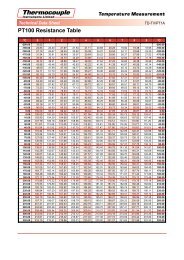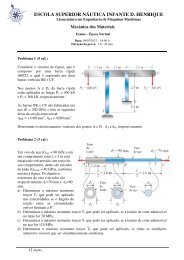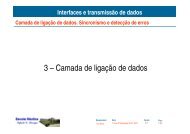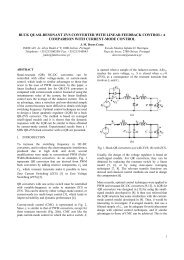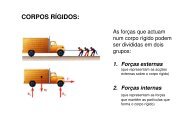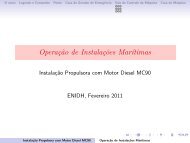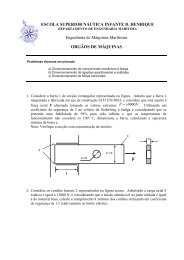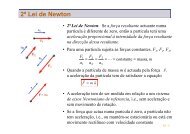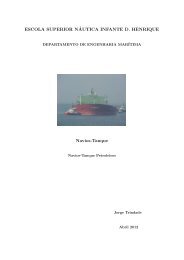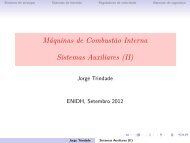Textos de Apoio (pdf)
Textos de Apoio (pdf)
Textos de Apoio (pdf)
You also want an ePaper? Increase the reach of your titles
YUMPU automatically turns print PDFs into web optimized ePapers that Google loves.
For bulkers and tankers, this coefficient<br />
is in the or<strong>de</strong>r of 0.98-0.99, and for<br />
container ships in the or<strong>de</strong>r of 0.97-0.98.<br />
Longitudinal prismatic coefficient C P<br />
The longitudinal prismatic coefficient<br />
C P<br />
expresses the ratio between displacement<br />
volume ∇ and the product<br />
of the midship frame section area A M<br />
and the length of the waterline L WL<br />
,<br />
see also Fig. 3, i.e.:<br />
C<br />
p<br />
∇<br />
∇<br />
= =<br />
A × L C × B × D×<br />
L<br />
M WL M WL WL<br />
C<br />
=<br />
C<br />
As can be seen, C P<br />
is not an in<strong>de</strong>pen<strong>de</strong>nt<br />
form coefficient, but is entirely <strong>de</strong>pen<strong>de</strong>nt<br />
on the block coefficient C B<br />
and the midship section coefficient C M<br />
.<br />
Longitudinal Centre of Buoyancy LCB<br />
The Longitudinal Centre of Buoyancy<br />
(LCB) expresses the position of the<br />
centre of buoyancy and is <strong>de</strong>fined as<br />
the distance between the centre of<br />
buoyancy and the mid-point between<br />
the ship’s foremost and aftmost perpendiculars.<br />
The distance is normally stated<br />
as a percentage of the length between<br />
the perpendiculars, and is positive if<br />
the centre of buoyancy is located to<br />
the fore of the mid-point between the<br />
perpendiculars, and negative if located<br />
to the aft of the mid-point. For a ship<br />
<strong>de</strong>signed for high speeds, e.g. container<br />
ships, the LCB will, normally, be negative,<br />
whereas for slow-speed ships,<br />
such as tankers and bulk carriers, it will<br />
normally be positive. The LCB is generally<br />
between -3% and +3%.<br />
Fineness ratio C LD<br />
The length/displacement ratio or fineness<br />
ratio, C LD<br />
, is <strong>de</strong>fined as the ratio<br />
between the ship’s waterline length L WL<br />
,<br />
and the length of a cube with a volume<br />
equal to the displacement volume, i.e.:<br />
C<br />
LD<br />
Ship’s resistance<br />
LWL<br />
=<br />
3<br />
∇<br />
To move a ship, it is first necessary to<br />
overcome resistance, i.e. the force working<br />
against its propulsion. The calculation<br />
of this resistance R plays a significant role<br />
B<br />
M<br />
in the selection of the correct propeller and<br />
in the subsequent choice of main engine.<br />
General<br />
A ship’s resistance is particularly influenced<br />
by its speed, displacement, and<br />
hull form. The total resistance R T<br />
, consists<br />
of many source-resistances R<br />
which can be divi<strong>de</strong>d into three main<br />
groups, viz.:<br />
1) Frictional resistance<br />
2) Residual resistance<br />
3) Air resistance<br />
The influence of frictional and residual<br />
resistances <strong>de</strong>pends on how much of<br />
the hull is below the waterline, while the<br />
influence of air resistance <strong>de</strong>pends on<br />
how much of the ship is above the waterline.<br />
In view of this, air resistance will<br />
have a certain effect on container ships<br />
which carry a large number of containers<br />
on the <strong>de</strong>ck.<br />
Water with a speed of V and a <strong>de</strong>nsity<br />
of has a dynamic pressure of:<br />
½ × × V 2 (Bernoulli’s law)<br />
Thus, if water is being completely<br />
stopped by a body, the water will react<br />
on the surface of the body with the dynamic<br />
pressure, resulting in a dynamic<br />
force on the body.<br />
This relationship is used as a basis<br />
when calculating or measuring the<br />
source-resistances R of a ship’s hull,<br />
by means of dimensionless resistance<br />
coefficients C. Thus, C is related to the<br />
reference force K, <strong>de</strong>fined as the force<br />
which the dynamic pressure of water<br />
with the ship’s speed V exerts on a<br />
surface which is equal to the hull’s wetted<br />
area A S<br />
. The rud<strong>de</strong>r’s surface is<br />
also inclu<strong>de</strong>d in the wetted area. The<br />
general data for resistance calculations<br />
is thus:<br />
Reference force: K = ½ × × V 2 × A S<br />
and source resistances: R = C × K<br />
On the basis of many experimental<br />
tank tests, and with the help of pertaining<br />
dimensionless hull parameters,<br />
some of which have already been discussed,<br />
methods have been established<br />
for calculating all the necessary<br />
resistance coefficients C and, thus, the<br />
pertaining source-resistances R. In<br />
practice, the calculation of a particular<br />
ship’s resistance can be verified by<br />
testing a mo<strong>de</strong>l of the relevant ship in<br />
a towing tank.<br />
Frictional resistance R F<br />
The frictional resistance R F<br />
of the hull<br />
<strong>de</strong>pends on the size of the hull’s wetted<br />
area A S<br />
, and on the specific frictional<br />
resistance coefficient C F<br />
. The<br />
friction increases with fouling of the<br />
hull, i.e. by the growth of, i.a. algae,<br />
sea grass and barnacles.<br />
An attempt to avoid fouling is ma<strong>de</strong> by<br />
the use of anti-fouling hull paints to<br />
prevent the hull from becoming<br />
“long-haired”, i.e. these paints reduce<br />
the possibility of the hull becoming<br />
fouled by living organisms. The paints<br />
containing TBT (tributyl tin) as their<br />
principal bioci<strong>de</strong>, which is very toxic,<br />
have dominated the market for <strong>de</strong>ca<strong>de</strong>s,<br />
but the IMO ban of TBT for new applications<br />
from 1 January, 2003, and a<br />
full ban from 1 January, 2008, may involve<br />
the use of new (and maybe not<br />
as effective) alternatives, probably copper-based<br />
anti-fouling paints.<br />
When the ship is propelled through the<br />
water, the frictional resistance increases<br />
at a rate that is virtually equal to the<br />
square of the vessel’s speed.<br />
Frictional resistance represents a consi<strong>de</strong>rable<br />
part of the ship’s resistance,<br />
often some 70-90% of the ship’s total<br />
resistance for low-speed ships (bulk<br />
carriers and tankers), and sometimes<br />
less than 40% for high-speed ships<br />
(cruise liners and passenger ships) [1]. The<br />
frictional resistance is found as follows:<br />
R F<br />
= C F<br />
× K<br />
Residual resistance R R<br />
Residual resistance R R<br />
comprises wave<br />
resistance and eddy resistance. Wave<br />
resistance refers to the energy loss<br />
caused by waves created by the vessel<br />
during its propulsion through the water,<br />
while eddy resistance refers to the loss<br />
caused by flow separation which creates<br />
eddies, particularly at the aft end<br />
of the ship.<br />
7


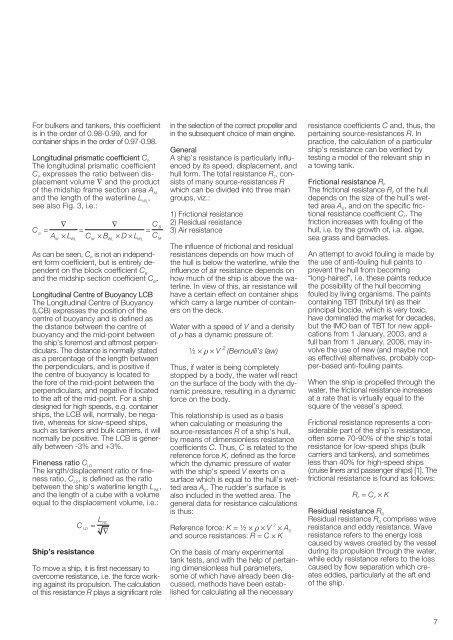
![Conceitos transmissao de dados .Sinais[.pdf]](https://img.yumpu.com/50982145/1/190x146/conceitos-transmissao-de-dados-sinaispdf.jpg?quality=85)
![Packages e interfaces[.pdf]](https://img.yumpu.com/50629553/1/190x134/packages-e-interfacespdf.jpg?quality=85)
